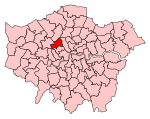Klooks Kleek

Klooks Kleek was a jazz and rhythm n’ blues club on the first floor of the Railway Hotel, West Hampstead, north-west London. Named after "Klook's Clique", a 1956 album by jazz drummer Kenny Clarke (Savoy Records 12006), the club opened on 11 January 1961 with special guest Don Rendell (tenor sax) and closed nine years later on 28 January 1970 after a session by drummer Keef Hartley’s group. There were over 1200 sessions at Klook’s Kleek, around 300 of them featuring jazz, and the others, rhythm ‘n’ blues. Zoot Money, Ten Years After, John Mayall and Graham Bond recorded live albums at Klooks Kleek. The British blues and rhythm and blues boom of the early 1960s brought to the club many living legends.
Excerpt from the Wikipedia article Klooks Kleek (License: CC BY-SA 3.0, Authors, Images).Klooks Kleek
West End Lane, London West Hampstead (London Borough of Camden)
Geographical coordinates (GPS) Address Nearby Places Show on map
Geographical coordinates (GPS)
| Latitude | Longitude |
|---|---|
| N 51.5463 ° | E -0.191 ° |
Address
The Railway
West End Lane 100
NW6 2LU London, West Hampstead (London Borough of Camden)
England, United Kingdom
Open on Google Maps









